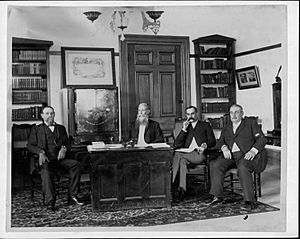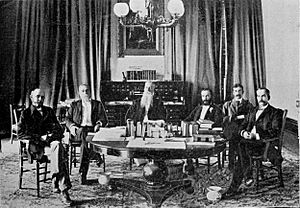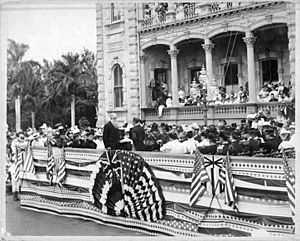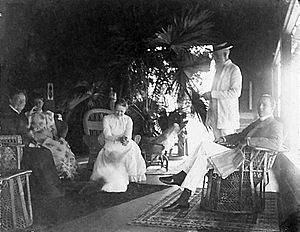Sanford B. Dole facts for kids
Quick facts for kids
Sanford B. Dole
|
|
|---|---|
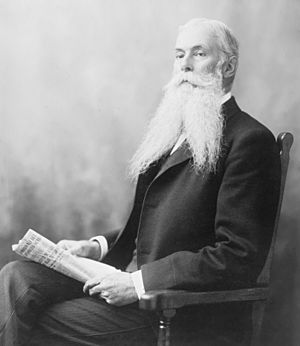 |
|
| 1st Territorial Governor of Hawaii | |
| In office June 14, 1900 – November 23, 1903 |
|
| Appointed by | William McKinley |
| Preceded by | Position established (Himself as President) |
| Succeeded by | George Carter |
| 1st President of Hawaii | |
| In office July 4, 1894 – August 12, 1898 |
|
| Preceded by | Position established (Liliuokalani as Queen) |
| Succeeded by | Position abolished (Himself as Governor) |
| Personal details | |
| Born |
Sanford Ballard Dole
April 23, 1844 Honolulu, Kingdom of Hawaii |
| Died | June 9, 1926 (aged 82) Honolulu, Territory of Hawaii, U.S. |
| Nationality | Kingdom of Hawaii Republic of Hawaii United States |
| Political party | Republican |
| Other political affiliations |
Reform Party |
| Spouse | Anna Prentice Cate Dole |
| Alma mater | Williams College |
Sanford Ballard Dole (born April 23, 1844 – died June 9, 1926) was an American-Hawaiian lawyer and judge. He lived during a time when Hawaii changed from being a kingdom to a protectorate, then a republic, and finally a territory of the United States.
Dole was born in Hawaii to American missionary parents. He believed in making Hawaii's government and culture more like Western countries. After the Hawaiian monarchy was overthrown, he became the President of the Republic of Hawaii. He worked to make Hawaii part of the United States.
Contents
Sanford Dole's Early Life
Sanford Dole was born on April 23, 1844, in Honolulu. His parents were Protestant Christian missionaries from Maine in the United States. His father, Daniel Dole, was the principal of Oahu College, which is now known as Punahou School. Sanford's mother, Emily Hoyt Ballard, died soon after he was born.
He was named after his uncle, Sanford K. Ballard. A native Hawaiian woman helped nurse him as a baby. In 1846, his father married Charlotte Close Knapp. In 1855, his family moved to Kōloa on the island of Kauaʻi, where they ran another school that Sanford attended.
Dole studied at Oahu College for one year. He then went to Williams College from 1866 to 1867. After that, he worked in a law office in Boston for a year. In those days, you could become a lawyer by learning from another lawyer. Later, in 1897, Williams College gave him an honorary law degree for being the first and only elected president of Hawaii.
In 1873, he married Anna Prentice Cate. In 1880, he became a Notary Public in Honolulu. Dole was elected to the legislature of the Hawaiian Kingdom in 1884 and 1886. He served from 1884 to 1887. During this time, he helped create the Hawaiian Constitution of 1887.
The "Bayonet Constitution"
In June 1887, local business owners, sugar planters, and politicians, supported by a group called the Honolulu Rifles, forced the King to remove his cabinet. They also made him accept a new document called the 1887 Constitution of the Kingdom of Hawaii.
This new constitution limited who could vote. Only literate men of Hawaiian, European, and American descent could vote. It also required voters to have certain income and wealth to vote for the House of Nobles. This meant that power was mostly held by the wealthy people on the island. The new constitution also greatly reduced the King's power, giving more power to his cabinet. Dole and other American lawyers helped write this document, which became known as the "Bayonet Constitution."
King Kalākaua made Dole a judge of the Supreme Court of the Kingdom of Hawaii in December 1887. He also appointed him to a group that would update the laws in January 1888. After King Kalākaua died, his sister Queen Liliʻuokalani appointed Dole to her Privy Council in August 1891.
The End of the Monarchy
The Hawaiian monarchy ended on January 17, 1893. This happened after the Kingdom of Hawaii was overthrown. Many of the same people who were involved in the 1887 revolt organized this overthrow. Dole did not officially join the Committee of Safety, but he helped them write their declaration.
Dole was chosen as president of the Provisional Government of Hawaii. This government was formed after the overthrow. Within 48 hours, all countries that had diplomatic ties with the Kingdom of Hawaii, including the United Kingdom, recognized this new government.
His cabinet, called the "executive council," included James A. King as minister of the interior, William Owen Smith as attorney general, and banker Peter Cushman Jones as minister of finance. Dole himself acted as Minister of Foreign Affairs until February 15, 1894. Later, Samuel Mills Damon became the Minister of Finance.
When Grover Cleveland became President of the United States, the Provisional Government's hopes of Hawaii becoming part of the U.S. were put on hold. President Cleveland even tried to help bring back the monarchy. He sent James Henderson Blount to investigate. The Blount Report in July 1893 said that the Committee of Safety worked with U.S. ambassador John L. Stevens to use the United States Marine Corps to remove Queen Liliʻuokalani from power. It also said they declared a Provisional Government made up of Committee of Safety members.
In November 1893, a U.S. representative named Albert Willis told the Queen that President Cleveland wanted her to forgive the people who overthrew her. In return, she would get her throne back. The Queen refused, saying that the revolutionists should be punished and their lands taken away. Willis claimed she even suggested they be put to death. Although she later said she never suggested this, her reported attitude made her lose the support of the Cleveland administration. Because of this, the U.S. recognized the Republic of Hawaii on July 4, 1894.
Another report, the Morgan Report in February 1894, said that the overthrow was a local event. It stated that it happened because of problems with the monarchy and that American troops did not try to cause the monarchy's fall. Instead, the report said the troops only acted to protect American property and citizens. Soon after, the Provisional Government held a meeting to write a new constitution. On July 4, 1894, they officially created the Republic of Hawaii.
President of Hawaii
Lorrin A. Thurston decided not to run for president of the Republic of Hawaii. So, Dole ran instead and won the election in 1894. Dole served as the first and only elected president of the Republic of Hawaii from 1894 to 1898. Dole then asked Thurston to lead the effort in Washington, D.C., to make Hawaii part of the United States.
Dole's government was recognized by every country that had recognized the Kingdom of Hawaii. He also dealt with several attempts to bring back the monarchy. One such attempt was a rebellion in January 1895 led by Robert William Wilcox. After being defeated, Wilcox and others involved were captured and sentenced to death. However, Dole reduced or changed their sentences. Queen Liliʻuokalani gave up her throne and, under pressure, promised loyalty to the Republic of Hawaii. She said that the Republic of Hawaii was the only lawful government of the Hawaiian Islands and that the monarchy was "finally and forever ended." She later wrote more about these events in her book, Hawaii's story by Hawaii's queen, Liliuokalani.
Governor and Judge
As president of the republic, Dole traveled to Washington, D.C., in early 1898. He went to personally ask for Hawaii to become part of the United States. On July 4, 1898, the U.S. Congress passed a joint resolution to make the Republic of Hawaii part of the U.S. This was known as the Newlands Resolution. It was named after its sponsor, U.S. Representative Francis Newlands. The resolution became law on August 12, 1898. A special ceremony was held that day at ʻIolani Palace. The Hawaiian flag was lowered, and the American flag was raised in its place. This marked the transfer of Hawaii's power to the United States.
Under the Newlands Resolution, Dole kept the powers he had as President of Hawaii. This was until Congress created a new government for the Hawaiian territory. Later, when the Hawaiian Organic Act established this new government, President William McKinley appointed Dole as the first governor of the Territory of Hawaii. Dole started his term on June 14, 1900. He resigned on November 23, 1903, to become a judge for the U.S. District Court of Hawaii. President Theodore Roosevelt appointed him to this role after the death of Morris M. Estee. He served as a judge until he retired on December 16, 1915. Horace Worth Vaughan replaced him.
Dole also served on groups that managed Honolulu parks and public records. He passed away on June 9, 1926, after having several strokes. His ashes were buried in the cemetery of Kawaiahaʻo Church.
Family and What He Left Behind
Dole's cousin, Edmund Pearson Dole, came to Hawaii in 1895 to practice law. He later became the Attorney General of Hawaii from 1900 to 1903. Another cousin, James Dole, arrived in Hawaii in 1899. He started the Hawaiian Pineapple Company on Oahu, which later became the Dole Food Company. James's father, Charles Fletcher Dole, also came to Hawaii in 1909.
Dole Middle School, located in Kalihi Valley on the island of Oʻahu, was named after him in April 1956. This was about a century after his father founded a school in Kōloa. In the movie Princess Kaiulani, the actor Will Patton played Sanford Dole.
In Hawaiian, the plant known as Spanish moss is called ʻumiʻumi-o-Dole, which means "Dole's beard." A bird species, Ciridops anna, was named after his wife, Anna.
More to Explore
 In Spanish: Sanford B. Dole para niños
In Spanish: Sanford B. Dole para niños


